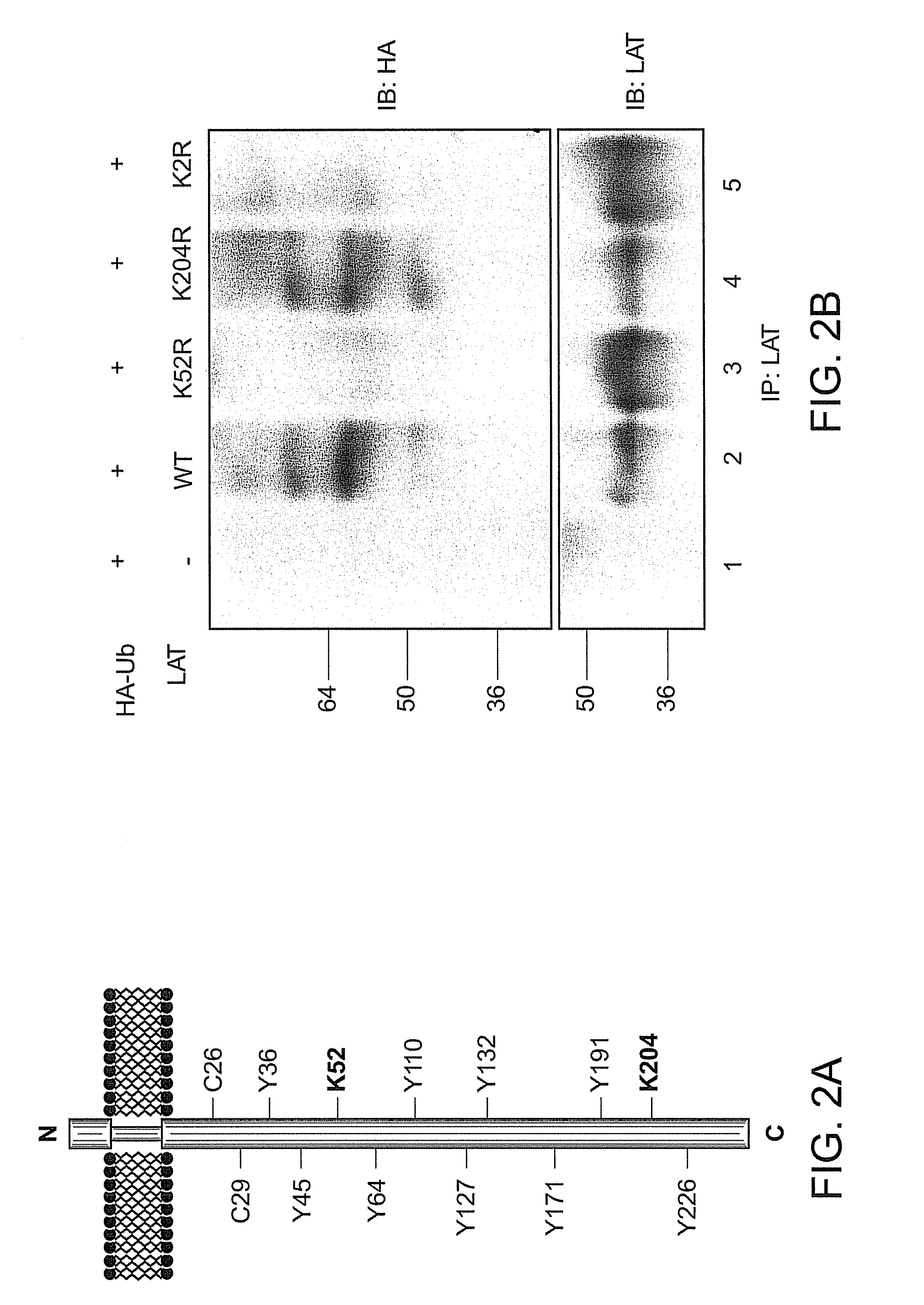Lat adapter molecule for enhanced t-cell signaling and method of use
a technology of t-cell signaling and adapter molecules, which is applied in the direction of peptide/protein ingredients, dna/rna fragmentation, depsipeptides, etc., can solve the problems of limited methods, inability to identify t-cells with a high avidity for desired antigens, and cell inactivation or inactivation, so as to increase the persistence of signaling in t-cells
- Summary
- Abstract
- Description
- Claims
- Application Information
AI Technical Summary
Benefits of technology
Problems solved by technology
Method used
Image
Examples
example 1
Materials and Methods
[0131]Reagents: Human anti-CD3ε (UCHT or HIT3a) monoclonal antibodies were purchased from Pharmingen and were used to coat coverslips. The following antibodies were used for western blotting and immunoprecipitation: Anti-HA-HRP (Roche), mouse anti-LAT (Upstate), mouse anti-β actin (SIGMA), rabbit anti-pLAT191 (Invitrogen), mouse anti-pY clone 4G10 (Millipore). APC-conjugated CD69 antibody was from BD Pharmingen. Indo-1 AM was from Invitrogen. OKT3 binding the human CD3-ε chain was used to trigger T cell activation.
[0132]COS-7 cell transfection, immunoprecipitation and immunoblotting: COS-7 cells were transfected using Lipofectamine® Plus reagent as recommended by the manufacturer (SIGMA®). Briefly, 60 mm dishes were seeded with cells and 70% confluent cell cultures were used for transfection. Cells were co-transfected with WT, K52, K204 or 2KR LAT (0.5 μg) and HA-Ub (0.5 μg). 24 hours post-transfection, cells were lysed in ice-cold Nonidet®-40 lysis buffer (50 m...
example 2
Human LAT is Ubiquitylated at Amino Acid 52
[0147]LAT contains a small extracellular domain, a single transmembrane spanning region and a long intracellular region with no apparent intrinsic enzyme activity or commonly described protein-protein interaction domains (FIG. 2A). The intracellular domain of LAT contains nine tyrosines of which five are phosphorylated (Y127, Y132, Y171, Y191, Y226) (Zhu, Jansen, Zhang J I 2003, Paz 2001), and two membrane proximal cysteine residues (C26 and C29) that are subject to posttranslational palmitoylation (Zhang 1998). LAT amino acid sequence also reveals two lysines (K52 and K204 in human LAT) that might serve as potential sites for ubiquitylation. Both LAT lysines were mutated either individually or in combination, and the potential ubiquitylation of these LAT proteins was evaluated. COS-7 cells were transfected with HA-tagged ubiquitin and wild-type (WT) LAT or LAT mutated on lysines, followed by immunoprecipitation of LAT and anti-HA western b...
example 3
Ubiquitin-Defective LAT is Internalized at Rates Comparable to Wild-Type LAT
[0148]To evaluate whether LAT ubiquitylation is required for LAT internalization, we assessed dynamics of wild-type and 2KR LAT. To this end, we tagged wild-type and 2KR LAT with a YFP tag at the carboxy terminus. Jurkat E6.1 cell lines were transfected with either wild-type LAT-YFP or 2KR LAT-YFP and trafficking of the fluorescent LAT constructs was evaluated. Both wild-type and 2KR LAT-YFP were recruited rapidly to signaling clusters in Jurkat E6.1 cells. High-speed microscopic analysis of activated cells in real time revealed that both wild-type LAT-YFP and 2KR LAT-YFP clusters dissipated soon after cluster formation in Jurkat E6.1 cells (FIG. 3). Similar dynamics of LAT-YFP clusters were observed in Jukat JCam2.5 cells that lack endogenous LAT. These data indicate that under conditions of severely reduced ubiquitylation, LAT internalization proceeds at regular rates, suggesting that ubiquitylation of LAT...
PUM
| Property | Measurement | Unit |
|---|---|---|
| molecular weight | aaaaa | aaaaa |
| molecular weight | aaaaa | aaaaa |
| molecular weight | aaaaa | aaaaa |
Abstract
Description
Claims
Application Information
 Login to View More
Login to View More - R&D
- Intellectual Property
- Life Sciences
- Materials
- Tech Scout
- Unparalleled Data Quality
- Higher Quality Content
- 60% Fewer Hallucinations
Browse by: Latest US Patents, China's latest patents, Technical Efficacy Thesaurus, Application Domain, Technology Topic, Popular Technical Reports.
© 2025 PatSnap. All rights reserved.Legal|Privacy policy|Modern Slavery Act Transparency Statement|Sitemap|About US| Contact US: help@patsnap.com



